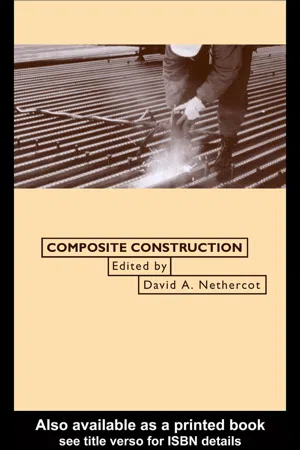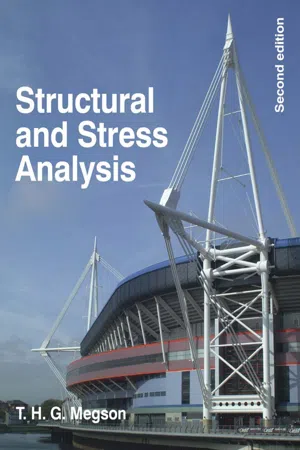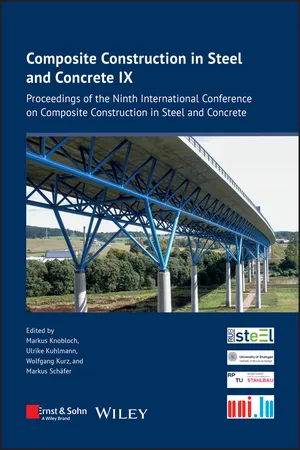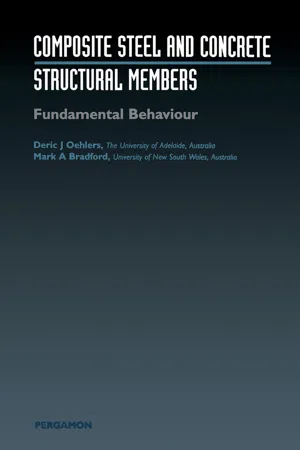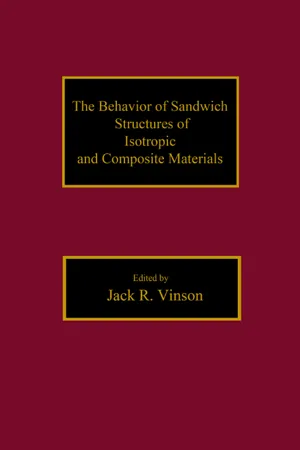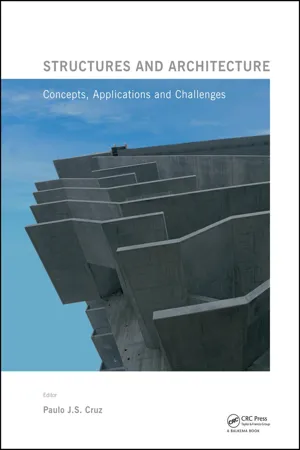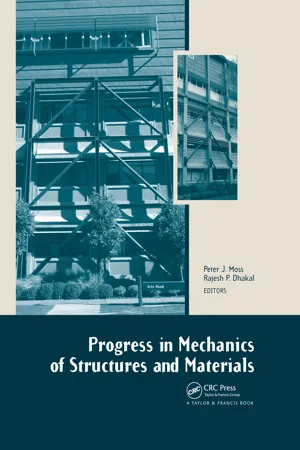Technology & Engineering
Composite Beam Sections
Composite beam sections are structural elements made by combining different materials, such as steel and concrete, to create a more efficient and versatile beam. By utilizing the strengths of each material, composite beam sections can achieve greater load-carrying capacity and stiffness compared to traditional beams. This makes them a popular choice in construction for supporting heavy loads over long spans.
Written by Perlego with AI-assistance
Related key terms
1 of 5
9 Key excerpts on "Composite Beam Sections"
- eBook - PDF
- David Nethercot(Author)
- 2001(Publication Date)
- CRC Press(Publisher)
Chapter 9 Composite construction Apart from certain, rather specialized types of structure, e.g. transmission towers, cranes, plant supports, etc., steelwork does not normally exist in isolation -despite a far too frequent but altogether misguided tendency for it to be designed as if it had no real interaction with anything else. However, one area in which the potential benefits of properly considering the combination of the steel frame with other structural elements is appre-ciated is in so-called composite construction. In this case the combination is between steel and reinforced concrete, although to some extent the concept is merely an extension of the more basic idea of reinforced con-crete. The principal difference is that steel sections capable of carrying significant load in their own right are used in composite construction; in conventional reinforced concrete the reinforcement is, of course, not really capable of functioning on its own as a structural element. The essential features of composite construction may best be appreci-ated by considering its most widely used application: the composite beam. Figure 9.1 illustrates the concept of a beam consisting of two constituent parts acting either separately or compositely. For the present the particu-lar materials or proportions do not matter; the key aspect is the difference in the mechanics of load resistance. For the non-composite arrangement the load will be shared between the two parts with each deforming in bending and generating separately the typical linear variation of strain over its own depth. Now consider the same arrangement but with continuity preserved along the horizontal interface so that both parts respond as a unit. Bending strains will now vary linearly over the whole depth, with the neutral axis for the combined figure 9. / Mechanics of composite action. Composite construction 183 section corresponding to the locus of zero strains. - eBook - ePub
- David Nethercot(Author)
- 2003(Publication Date)
- CRC Press(Publisher)
CHAPTER TWO: Composite BeamsHoward D. Wright
2.1 INTRODUCTION
Composite beams may well be the most common form of composite element in steel frame building construction and have been the major form for mid range steel bridges. As the main criterion for design is flexure, the study of composite beams provides an explanation to the associated behaviour of many other composite elements such as composite slabs, composite columns subject to lateral loads and composite joints between beams and columns.As a basis for the work in this chapter, composite beams are defined as; “elements resisting only flexure and shear that comprise two longitudinal components connected together either continuously or by a series of discrete connectors”. Furthermore it is assumed that the two components are positioned directly one above each other with their respective centroids vertically above each other.Composite beams vary in behaviour from the situation when the connection between the two layers is non-existent to the situation where the bond between the layers approaches infinite stiffness and strength. There is also the influence of the contrast in material properties of the two layers. A weak and flexible layer will have little influence in the overall strength and stiffness of the beam. Consequently the influence of the difference in strength and stiffness of the components and in particular the strength and stiffness of the connection between them plays a vital role. In addition, the stress states in each component that exist prior to connection may also affect behaviour. The overall analysis and design of composite beams is, therefore, significantly more complex than for single material beams. - eBook - ePub
Design and Analysis of Composite Structures
With Applications to Aerospace Structures
- Christos Kassapoglou, Peter Belobaba, Jonathan Cooper, Roy Langton, Allan Seabridge, Peter Belobaba, Jonathan Cooper, Roy Langton, Allan Seabridge(Authors)
- 2013(Publication Date)
- Wiley(Publisher)
8 Design and Analysis of Composite BeamsThe term beams is used here as a generic term referring to all one-dimensional parts that may be used in a structure. These include stiffeners, stringers, panel breakers, etc. There are many cross-sectional shapes that are used in practice. Of those, the ones used most frequently are (Figure 8.1 ) L or angle, C or channel, Z, T or blade, I, J and Hat or omega.8.1 Cross-Section Definition Based on Design GuidelinesFigure 8.1 Typical beam cross-sectionsFor a composite beam such as the one shown in Figure 8.2 , each member may have a different layup. This would result in different stiffnesses and strengths for each of the flanges and web and would allow more efficient usage of composite materials through tailoring. Typically, the letter b with appropriate subscript is used to denote the longer dimension of each member and the letter t the shortest (the thickness).Figure 8.2 J stiffener cross-sectionAs beams tend to be used in stability-critical situations, cross-sections with high moments of inertia are preferred. Besides the obvious implications for the beam geometry (high b 2 value, e.g. in Figure 8.2 ), there are certain guidelines that relate to the layup, which, when implemented, also contribute to robust performance.With reference to Figure 8.2 , stiff material must be located as far from the neutral axis as possible. Defining the 0 direction to be aligned with the beam axis (perpendicular to the plane of Figure 8.2 ), this stiffness requirement would result in the two flanges, the one next to the skin and the one away from the skin, being made up of mostly 0° plies.Another clue can be deduced from the theory of joints (see, e.g. [1, 2]). It has been demonstrated that as the thickness of the adherends decreases, the strength of the joint increases because the peak stresses at the end of each adherend, where the load transfer to the adhesive is completed, are lower. This implies that the stiffness mismatch caused by the adherend termination is less and the associated stress concentration is reduced. A similar situation occurs in testing coupons (in tension) using bevelled tabs. The bevel in the tabs reduces the local stresses and helps eliminate the possibility of specimen failure at tab termination. With this background, it is easy to deduce that by decreasing the stiffness mismatch between the flange next to the skin and the skin itself, the possibility of skin failure or flange/skin separation is reduced. This means that - eBook - PDF
- T.H.G. Megson(Author)
- 2005(Publication Date)
- Butterworth-Heinemann(Publisher)
C h a p t e r 12 / Composite Beams Frequently in civil engineering construction beams are fabricated from comparatively inexpensive materials of low strength which are reinforced by small amounts of high-strength material, such as steel. In this way a timber beam of rectangular section may have steel plates bolted to its sides or to its top and bottom surfaces. Again, concrete beams are reinforced in their weak tension zones and also, if necessary, in their compression zones, by steel-reinforcing bars. Other instances arise where steel beams support concrete floor slabs in which the strength of the concrete may be allowed for in the design of the beams. The design of reinforced concrete beams, and concrete and steel beams is covered by Codes of Practice and relies, as in the case of steel beams, on ultimate load analysis. The design of steel-reinforced timber beams is not covered by a code, and we shall therefore limit the analysis of this type of beam to an elastic approach. 12.1 S TEEL-REINFORCED T IMBER B EAMS The timber joist of breadth b and depth d shown in Fig. 12.1 is reinforced by two steel plates bolted to its sides, each plate being of thickness t and depth d . Let us suppose that the beam is bent to a radius R at this section by a positive bending moment, M . Clearly, since the steel plates are firmly attached to the sides of the timber joist, both are bent to the same radius, R . Then, from Eq. (9.7), the bending moment, M t , carried z y d G t t b F IGURE 12.1 Steel-reinforced timber beam 300 12.1 Steel-reinforced Timber Beams • 301 by the timber joist is M t = E t I t R (12.1) where E t is Young’s modulus for the timber and I t is the second moment of area of the timber section about the centroidal axis, Gz . Similarly for the steel plates M s = E s I s R (12.2) in which I s is the combined second moment of area about Gz of the two plates. - eBook - PDF
Composite Construction in Steel and Concrete IX
Proceedings of the Ninth International Conference on Composite Construction in Steel and Concrete
- Markus Knobloch, Ulrike Kuhlmann, Wolfgang Kurz, Markus Schafer(Authors)
- 2024(Publication Date)
- Ernst & Sohn(Publisher)
COMPOSITE STRUCTURAL ELEMENTS Composite Construction in Steel and Concrete IX: Proceedings, Eds. M. Knobloch, U. Kuhlmann, W. Kurz, M. Schäfer. © 2024 Ernst & Sohn GmbH. Published 2024 by Ernst & Sohn GmbH. 283 COMPOSITE STRUCTURAL ELEMENTS 9 TH INTERNATIONAL CONFERENCE ON COMPOSITE CONSTRUCTION IN STEEL AND CONCRETE M. Knobloch, U. Kuhlmann, W. Kurz, M. Schäfer. (Eds.) 2QOLQH *HUPDQ\ -XO\ BEHAVIOUR AND DESIGN OF HIGH-PERFORMANCE STEEL AND STEEL-CONCRETE COMPOSITE STRUCTURES D. Li*, B. Uy*, Z. Huang* and M. Khan* * School of Civil Engineering, The University of Sydney, Sydney, NSW 2006, Australia e-mails: [email protected], [email protected], [email protected], [email protected] Keywords: High-strength bolts, High-performance steel, Steel-concrete composite column Abstract. Owing to the significant benefits, an increasing popularity to adopt the high-strength materials in the construction industry was witnessed over the recent years. With it comes a series of studies that investigated the mechanical performance of high-strength steel components, which aimed to encourage a more widespread utilisation in engineering practice. Many of the previous research relating to high- strength steel/composite structures have been focused on hot-rolled and cold-formed sections, whereas applications have been focused on thick and fabricated components in mostly high-rise and heavily loaded structures. Therefore, a research program funded by the Australian Research Council was initiated in 2018 and comprehensive experimental and numerical studies were performed over the past three years. This paper summarises the major findings on high-strength bolts, as well as fabricated high- and ultra-high- strength steel/composite structural members. 1 INTRODUCTION High-performance materials have found an increasing popularity in the construction industry over the recent years. - eBook - PDF
Composite Steel and Concrete Structures: Fundamental Behaviour (Second Edition)
Composite Steel and Concrete Structures: Fundamental Behaviour (Second Edition)
- D.J. Oehlers, M.A. Bradford(Authors)
- 2013(Publication Date)
- Pergamon(Publisher)
Darwin, D. (1988). Draft -Design of steel and composite beams with web openings, American Iron and Steel Institute, U.S.A.. Narayanan, R. (1988). Steel-Concrete Composite Structures, Stability and Strength, Elsevier Applied Science, London. Patrick, M. and Poon, S.L. (1989). Composite Beam Design and Safe Load Tables. Australian Institute of Steel Construction, Sydney. Redwood, R.G. and Poumbouras, G. (1983). Tests of composite beams with web holes, Canadian Journal of Civil Engineering, Vol. 10, No. 4, 713-21. Redwood, R.G. and Poumbouras, G. (1984). Analysis of composite beams with web openings, Journal of Structural Engineering, ASCE, Vol. 110, No. 9, 1949-58. Redwood, R.G. and Wong, P.P.K. (1982). Web holes in composite beams with steel deck, Proceedings 8th Canadian Structural Engineering Conference, Canadian Steel Construction Council, Vancouver, February. 16 Composite Profiled Slabs and Profiled Decking 16.1 Introduction In Parts 3, 4 and 5 of this book, we have dealt primarily with one-way composite T-beams, consisting usually of a steel I-section element which is composite with a fairly narrow concrete slab. In bridges, it is usual to construct the narrow concrete element with conventional formwork which is stripped after the concrete has cured, so that its soffit is flat. A slab in a building is one for which the thickness is usually an order of magnitude less than the geometric dimensions such as length and slab width, and these are generally constructed by using light-gauge cold formed steel profiled decking as the soffit, as in Fig. 1.3(c). Composite profiled slabs constructed from profiled decking have two major advantages over slabs with off-form soffits. Firstly, the decking provides permanent and integral formwork for the slab during construction, so that it is not necessary to strip the timber forms as would be required for a flat soffit slab. - JackR. Vinson(Author)
- 2018(Publication Date)
- Routledge(Publisher)
CHAPTER 4 Beams, Columns, and Rods of Composite Materials 4.1 DEVELOPMENT OF CLASSICAL BEAM THEORYA beam, column, or rod is a long thin structural component of width b, height h, and length L, where b/L ≪ 1 and h/L ≪ 1, as shown in Figure 4.1 . Its loading and its response to that loading occur in the x-z plane only. It should be noted that if these are loads in the y-z plane, those are treated exactly analogous to the loadings and response in the x-z plane. Subsequently, superposition is used to analyze the response to both loadings if the loads occur simultaneously.Furthermore, if the ()16 and ()26 coupling terms exist in the constitutive relations, then x-z, y-z plane coupling exist and the structure of Figure 4.1 does not behave as a beam, but behaves as a long, thin plate.The term beam is utilized when the structure of Figure 4.1 is subjected to a lateral load in the x-z plane, in the z-direction, distributed and/or concentrated, applied to the upper and/or lower surface (that is, z = ±h/2), such that bending (curvature, in the x-z plane) occurs. The term “rod” is used when the structure of Figure 4.1 is loaded in the axial direction (the x-direction) by tensile forces which try to “stretch” the structure. The term “column” is used when the structure shown is subjected to compressive forces in the x-direction which reduces the length of the structure, resulting in compressive stresses, and/or elastic instability (buckling) of the structure, which will be discussed later in this chapter. Combinations of these loads may occur, such as when lateral and in-plane compressive loads occur simultaneously, resulting in the structure being referred to as a “beam column.”As a simple first example, consider the beam to be loaded in the x-z plane only, whether the loading is lateral, in-plane tensile, in-plane compressive, or combinations thereof. Also, for simplicity, ignore the thermal and moisture effects (that is, hygrothermal effects) which add on to the strain terms in the constitutive equations given in Chapter 2 . Because a beam is so narrow (b ≪ L), strains are ignored in the y- eBook - PDF
Structures and Architecture
New concepts, applications and challenges
- Paulo J. Cruz(Author)
- 2013(Publication Date)
- CRC Press(Publisher)
Further the design of composite connection provides significant potential for structural optimization. This potential is outlined and design guidance for simplified and sustainable composite design is given. Structures and Architecture: Concepts, Applications and Challenges – Cruz (ed) © 2013 Taylor & Francis Group, London, ISBN 978-0-415-66195-9 1523 load bearing resistance, deflection and vibration comfort, heat- and sound insulation and fire re- sistance as well as it should be quick and easy erectable. A short delivery time is presupposed. These criteria are considered in the solutions selection process of this paper. Further the connec- tions of composite construction offer a large potential for design optimization. Therefore design guidance for simplified and sustainable design of composite connection is given. Design exam- ples show the potential of the proposed systems and give orientation in design. 2 NEW COMPOSITE SLAB SYSTEMS 2.1 The standard composite slab system Economic, efficient and competitive constructions are requested with low material consumption and simple and fast assembly methods. Steel and concrete composite structures offer a wide range of answers to these demands with the possibility to create a column grid with large spans to serve the architectural demand for wide, open and flexible useable internal office space. Fur- ther easy integration of the building services is possible and stays accessible after installation. Construction methods which allow for a high degree of pre-fabrication are associated with com- posite construction. A typical composite slab consists of trapezoidal steel sheetings as lost formwork for a rein- forced concrete slab. The sheet carries the self-weight of the concrete during the casting process. - eBook - PDF
Progress in Mechanics of Structures and Materials
Proceedings of the 19th Australasian Conference on the Mechanics of Structures and Materials (ACMSM19), Christchurch, New Zealand, 29 November - 1 December 2006
- Peter J. Moss, Rajesh P. Dhakal(Authors)
- 2020(Publication Date)
- CRC Press(Publisher)
The behaviour of full-scale concrete-LVL composite beams that were tested to failure is also described. The feasibility of using proprietary lightweight concrete panels for the slab, and using straight and draped prestressing tendons is also explored. The best cost-to-benefit ratio is shown to be provided by the plain composite structure where, again, the connection system is the most important aspect of providing good structural performance. INTRODUCTION Composite concrete and timber beams (CCTs) represent a structural technique widely used for both strength and stiffness upgrading of existing and new floors. This technique consists of connecting an exist- ing or new timber beam to a concrete slab cast above the timber beam using a suitable connection system (Ceccotti 1995). Steel mesh is usually cast into the slab to resist potential tensile stresses due to bending, and to reduce the concrete crack width. This provides many benefits for timber floors, including greater strength and stiffness, less susceptibility to vibration, improved seismic and fire resistance, better acoustic separation and thermal mass. The lower weight than reinforced concrete floors also needs to be highlighted. The performance of the CCT beam elements largely depends on the choice of the connection system. Stiff shear connections are required to provide optimal structural efficiency. While they do not need high strength, they should deform in a ductile manner (Frangi & Fontana 2003, Ceccotti et al. 2006). Plas- ticization of the connection normally provides some ductility in the CCT element, since both timber and concrete exhibit quite brittle behaviour (in tension and compression respectively). On the other hand, the con- nection system needs to be inexpensive to manufacture and install in order to make CCT beams competi- tive with other construction systems.
Index pages curate the most relevant extracts from our library of academic textbooks. They’ve been created using an in-house natural language model (NLM), each adding context and meaning to key research topics.

